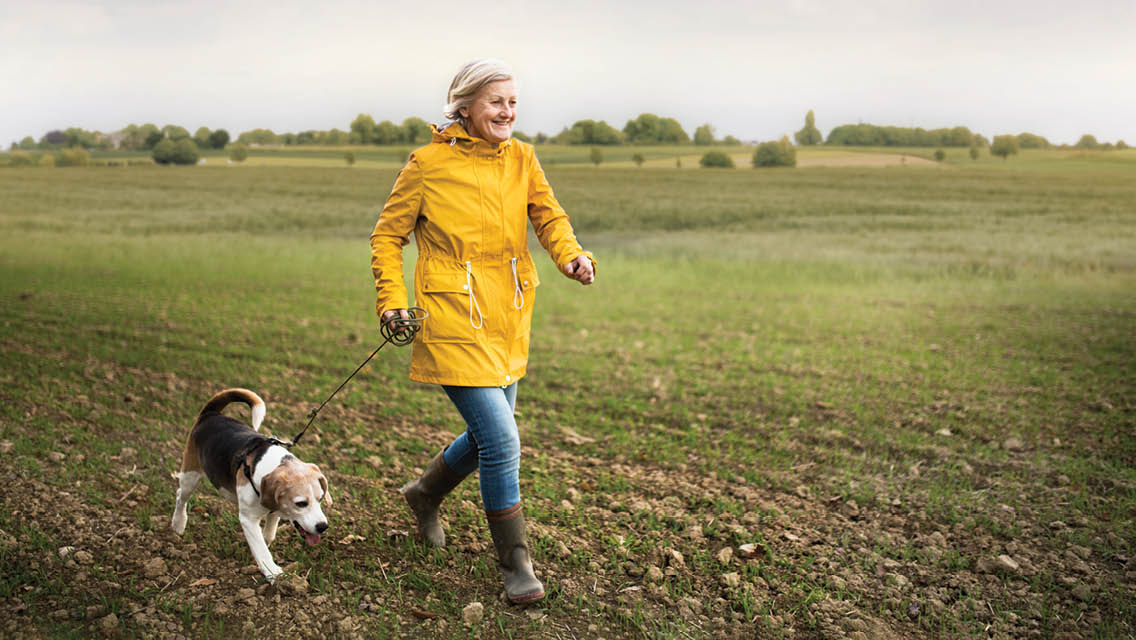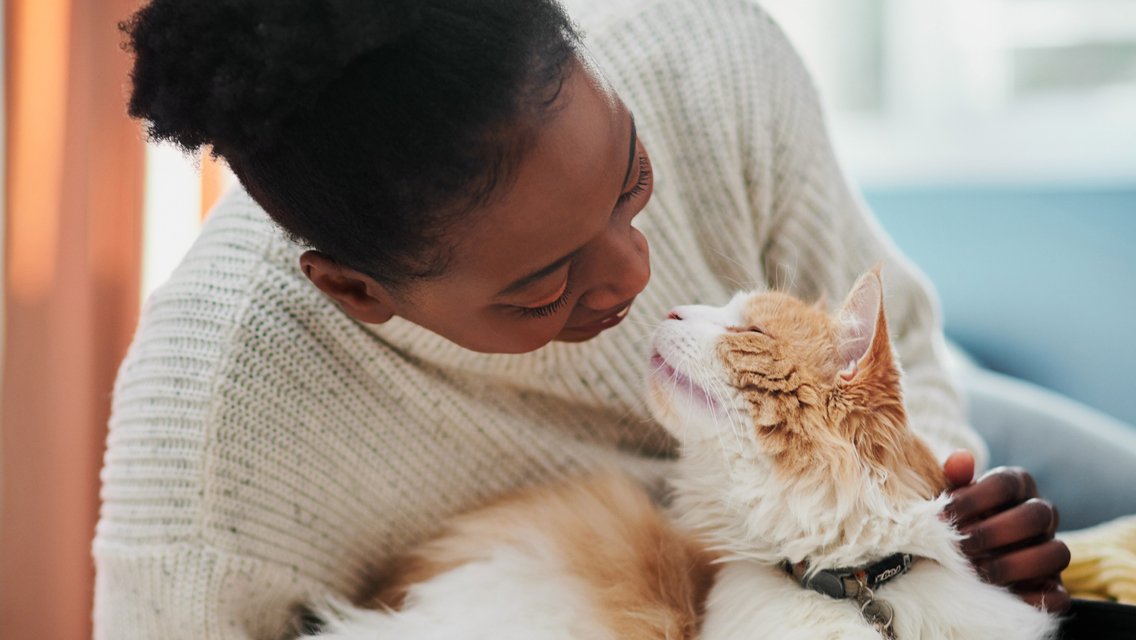|
Listen to this article:
|
Anne Diffily’s closest relationship during the pandemic — aside from the one with her partner — was with Yogi, her 15-year-old pit-bull mix. So as Yogi faced health issues, the Warwick, R.I., retiree took each new stage in stride.
Yogi’s needs included teeth extraction, anal-gland removal, and painkillers for arthritis — which had to be increased in dosage three times. Today, Yogi is nearly deaf, partially blind, and occasionally incontinent.
“It’s expensive to have an older pet,” says Diffily. But Yogi was there for her when she needed him, and she wants to be there for Yogi.
Research shows that living with pets conveys a number of health benefits. Their companionship helps reduce stress, anxiety, and loneliness, according to the Centers for Disease Control and Prevention. Pets offer more opportunities to socialize, exercise, and spend time outside — all of which lowers our cholesterol, triglyceride levels, and blood pressure.
Perhaps because animals can add so much meaning to our lives, many people dread the prospect of watching their furry friends age. Yet veterinarians and experienced senior-pet companions say this stage of life offers its own kind of joy and opportunity for fulfillment.
If you tune in to your pet’s changing needs and seek out the appropriate resources, you can extend their life — and improve their quality of life — more than you might imagine.
If you tune in to your pet’s changing needs and seek out the appropriate resources, you can extend their life — and improve their quality of life — more than you might imagine. “We can do so much for pain and anxiety management, and there are lots of practical steps you can take in the home to keep them safe,” says Mary Gardner, DVM, a hospice veterinarian based in South Florida and author of It’s Never Long Enough: A Practical Guide to Caring for Your Geriatric Dog.
Proper treatment can relieve pain and even improve your pet’s arthritis or tricky hip. Moreover, preventive steps can slow the aging process by months or years, giving you precious additional time with your best pal.
Keeping Pets Healthy
Even before your pets reach their geriatric years, you can do a lot to keep them healthy and happy.
Activity. Like humans, pets need regular exercise to maintain muscle mass and a healthy weight. Play with your adult cats just as you would when they were kittens, for movement and cognitive stimulation. Let your dog walk until they signal that they’re ready to go home, says Nicholas Dodman, DVM, president of the Center for Canine Behavior Studies and editor of Good Old Dog: Expert Advice for Keeping Your Aging Dog Happy, Healthy, and Comfortable.
“Swimming is one of the best exercises for senior dogs with arthritis,” notes Ursula Liv, owner of Liv Love Dogs, a canine health and wellness consultancy based in Southern California — though she advises not to let dogs swim alone. (Looking for adventurous inspiration with your pup? See “5 Adventures to Take With Your Dog.”)
Diet and Supplements. Consult your veterinarian to be sure you’re feeding your pets the optimal diets for their age and condition. Ask about supplements, such as omega-3 fats, vitamin D, antioxidants, digestive enzymes, and probiotics. Don’t overfeed them or give them too many treats — carrying too much weight can worsen many ailments, including joint pain and heart disease.
Brain Games. Pets also need mental stimulation. For dogs, this means varying walk routes, letting them off-leash when it’s safe, and allowing them to linger and sniff every bush or post they desire. “He’s checking his pee-email,” Dodman explains. “He’s doing something interesting that stimulates his brain.”
For cats and indoor pets, consider using various tools to keep them engaged, such as wobble bowls, lick mats, and food puzzles.
Signs of Change
As your pet ages, pay close attention to changes in their activity level, appetite, general attitude, and continence. Gardner recommends taking regular photos and videos so you can track subtle differences.
For example, a cat relinquishing the sunny window seat may be signaling that she feels pain when climbing up to that spot. A dog who stops and stares during a walk could be experiencing cloudy vision or confusion.
Ask your vet whether checkups should be more frequent than once per year so any new conditions that require treatment can be caught more quickly. “Sadly, 50 percent of pets who are euthanized were not seen by a vet in the previous year,” Gardner says, adding that this figure does not include shelter animals.
To cover the costs of your pet’s medical emergencies, consider pet insurance or simply start saving in a separate account.
Adjusting to Older Pets
You may need to adapt your lifestyle to accommodate your pet’s needs and to keep them safe, clean, and active. Observe your home with an eye out for slipping and falling hazards. “Make sure the pet has secure footing all around where they want to be,” Gardner says.
If the cat likes to sit beside you on the couch or the dog wants to stand next to you at the sink, lay a path of yoga mats or bathmats so they can easily get that companionship that sustains them.
Keep in mind that many old-age illnesses in pets cause incontinence, so you may need to avoid leaving them alone indoors for long periods. Be sure they can access a litter box or area to relieve themselves.
Adaptive harnesses, toe grips, and booties can encourage older pets to move more often. Consider raising or tilting food and water bowls if your pet has trouble leaning down to eat or drink.
When Is It Time?
It’s what all pet owners dread: making the decision to euthanize a pet. Take the time to consider the pet’s quality of life and prognosis, as well as your own resources, Gardner advises.
The Pawspice (pronounced like “hospice”) quality-of-life program for terminal pets suggests assessing seven areas: hurt, hunger, hydration, hygiene, happiness, mobility, and whether there are more good days than bad.
Dodman recommends convening a committee to discuss the situation. This could include the veterinarian, family members (including children no longer living at home), and a friend who can offer an impartial opinion.
There’s no reason to feel guilt or shame about reaching the decision to say goodbye to your pet, says Gardner. “It’s not about giving up,” she explains. “Euthanasia is very peaceful and can be an end to suffering.”
Diffily believes our pets let us know when they’re ready. Before Yogi arrived, she had an 85-pound dog named Bonnie who couldn’t walk after an amputation, but at age 12 still loved being carried onto the porch to sit with Diffily and her husband. One day, Bonnie just looked up at them pleadingly. “We both said, ‘She can’t do this anymore,’” she recalls.
Saying Goodbye With Intention
Once you’ve made the decision that it’s time, don’t rush. Give yourself a day or two to prepare and make memorial items. Maybe you want a paw print, photos, or a clipping of fur. Take your pet to their favorite spot for one last outing, and make sure everyone gets to say goodbye.
Try to avoid crying or moping, which our pets can easily sense. “Make sure their last days aren’t stressful,” Liv says. “Spoil them, brush them, do all the things they love.”
Make an appointment at the vet or with a service that can come to your home, which may be a less anxiety-provoking option for many pets and their people. “We hold them, we tell them it’s OK to leave, we pet them,” Liv notes. “Be there in the last moments and let them see your face last rather than a vet’s.”
Recognize that you may grieve more than you expected. “Some people have a harder time losing their pet than a human family member,” Liv says. “They’re with you all day, every day.” When you’re ready, seek out resources: Many organizations, such as Lap of Love and Rainbows Bridge, offer support for pet-loss grief.
Above all, find comfort in knowing that you gave your pet a good life and a loving home — and that the grief you feel is an echo of the joy they brought you.
Balance
Explore more empowering strategies to support your efforts to live in (closer) alignment with your values at our Balance department.
This article originally appeared as “Caring for an Aging Pet” in the April 2023 issue of Experience Life.





This Post Has 0 Comments